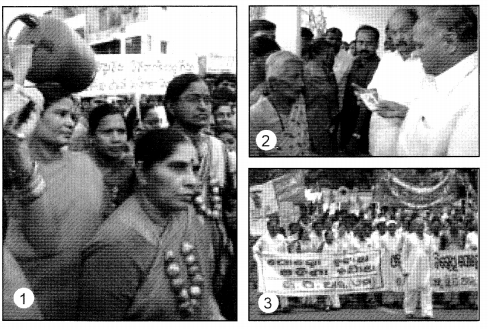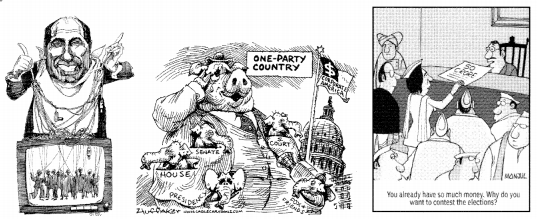Check the below NCERT MCQ Questions for Class 10 Civics Chapter 6 Political Parties with Answers Pdf free download. MCQ Questions for Class 10 Social Science with Answers were prepared based on the latest exam pattern. We have Provided Political Parties Class 10 Civics MCQs Questions with Answers to help students understand the concept very well. https://mcqquestions.guru/mcq-questions-for-class-10-civics-chapter-6/
Political Parties Class 10 MCQs Questions with Answers
Choose the correct option:
Political Parties Class 10 MCQ Question 1.
Which one of the following facilities is offered by the Election Commission to a recognised political party?
(a) Party name
(b) Election funds
(c) Election symbol
(d) Manifesto
Answer
Answer: (c) Election symbol
MCQ On Political Parties Class 10 Question 2.
Which one of the following is a ‘National Political Party’?
(a) Samajwadi Party
(b) Rashtriya Janata Dal
(c) Rashtriya Lok Dal
(d) Bahujan Samaj Party
Answer
Answer: (d) Bahujan Samaj Party
MCQ Of Political Parties Class 10 Question 3.
Who among the following recognises political parties in India?
(a) Election Commission
(b) President of India
(c) Speaker of Lok Sabha
(d) Supreme Court
Answer
Answer: (a) Election Commission
Class 10 Political Parties MCQ Question 4.
Which one of the following countries has one party system?
(a) China
(b) Indo-China
(c) Japan
(d) Germany
Answer
Answer: (a) China
Political Parties Class 10 MCQ With Answers Question 5.
In which of the following states does Shiv Sena exist as a regional political party?
(a) Gujarat
(b) Karnataka
(c) Maharashtra
(d) Madhya Pradesh
Answer
Answer: (c) Maharashtra
Political Parties MCQ Class 10th Question 6.
Name the political party that emerged out of mass movement?
(a) DMK
(b) Janata Dal
(c) Forward Bloc
(d) Bahujan Sam
Answer
Answer: (b) Janata Dal
Class 10 Civics Chapter 6 MCQ With Answers Question 7.
A recognised political party is
(a) a party that is present in only one of the federal units.
(b) a party that is present in several and all units of the federation.
(c) a party that is based on regional and communal diversities.
(d) a party recognised by the ‘Election Commission’ with all the privileges and facilities.
Answer
Answer: (d) a party recognised by the ‘Election Commission’ with all the privileges and facilities.
MCQ Political Parties Class 10 Question 8.
An example of a country having the multi party system is
(a) China
(b) USA
(c) India
(d) United Kingdom
Answer
Answer: (c) India
Political Parties Class 10 MCQs Question 9.
How many parties are needed in any democratic system to compete in elections and provide a fair chance for the competing parties ; to come to power?
(a) Less than two
(b) At least two parties
(c) More than two parties
(d) At least three parties
Answer
Answer: (b) At least two parties
MCQ Of Chapter Political Parties Class 10 Question 10.
The number of political parties registered with the Election Commission of India is
(a) 750 parties
(b) more than 750 parties
(c) Less than 750 parties
(d) 705 parties
Answer
Answer: (b) more than 750 parties
Political Party Class 10 MCQ Question 11.
How many parties are registered with the Election Commission of India?
(a) 250
(b) 300
(c) 500
(d) More than 750
Answer
Answer: (d) More than 750
Explanation:
There are a large number of political parties in each country. More than 750 parties are registered with the Election Commission of India.
Political Parties MCQ Class 10 Question 12.
What is a signed document submitted to an officer regarding her personal information?
(a) Affidavit
(b) Declaration
(c) Agreement
(d) Appeal
Answer
Answer: (a) Affidavit
Explanation:
An affidavit is a signed document submitted to an officer, where a person makes a sworn statement regarding her personal information.
MCQs Of Political Parties Class 10 Question 13.
Which of these statements is incorrect about CPI (M)?
(a) Supports socialism, secularism and democracy
(b) Opposes imperialism and communalism
(c) Wants to secure socio-economic justice in India
(d) None of the above
Answer
Answer: (d) None of the above
Explanation:
CPI(M) supports socialism, secularism and democracy and opposes imperialism and communalism. Accepts democratic elections as a useful and helpful means for securing the objective of socio- economic justice in India.
MCQ Of Political Parties Question 14.
Who chooses the candidates for contesting elections in India?
(a) Members and supporters of the party
(b) Top party leadership
(c) The existing government
(d) None of these
Answer
Answer: (b) Top party leadership
Explanation:
In other countries like India, top party leaders choose candidates for contesting elections.
MCQs On Political Parties Question 15.
When and under whose leadership was Bahujan Samaj Party (BSP) formed?
(a) 1982, Mayawati
(b) 1984, Kanshi Ram
(c) 1985, Mulayam Singh Yadav
(d) 1986, Bhajanlal
Answer
Answer: (b) 1984, Kanshi Ram
Explanation:
Bahujan Samaj Party (BSP) was formed in 1984 under the leadership of Kanshi Ram. Seeks to represent and secure power for the bahujan samaj which includes the dalits, adivasis, OBCs and religious minorities.
Question 16.
When was the BJP founded?
(a) 1960
(b) 1970
(c) 1980
(d) 1990
Answer
Answer: (c) 1980
Explanation:
Bharatiya Janata Party (BJP) was founded in 1980 by reviving the erstwhile Bharatiya Jana Sangh.
Question 17.
How many recognised national parties were there in 2006?
(a) 5
(b) 6
(c) 7
(d) 8
Answer
Answer: (b) 6
Explanation:
According to the classification, there were six national recognised parties in the country in 2006
Question 18.
What are the parties which are given the special privilege of ‘election symbol’ and other facilities?
(a) ‘Identified’ by the Election Commission
(b) ‘Recognised’ by the Election Commission
(c) ‘Patronised’ by the Election Commission
(d) ‘Attached’ by the Election Commission
Answer
Answer: (b) ‘Recognised’ by the Election Commission
Explanation:
Parties that get this privilege and some other special facilities are ‘recognised’ by the Election Commission for this purpose. That’s why these parties are called, ‘recognised political parties’.
Question 19.
Which of these alliances were there in 2004 parliamentary elections in India?
(a) National Democratic Alliance
(b) The United Progressive Alliance
(c) Left Front
(d) All the above
Answer
Answer: (d) All the above
Explanation:
In India there were three such major alliances in 2004 parliamentary elections– the National Democratic Alliance, the United Progressive Alliance and the Left Front.
Question 20.
Which of these is not a good option for a democratic state?
(a) One-party system
(b) Two-party system
(c) Multi-party system
(d) None of the above
Answer
Answer: (a) One-party system
Explanation:
We cannot consider one-party system as a good option because this is not a democratic option. Any democratic system must allow at least two parties to compete in elections and provide a fair chance for the competing parties to come to power.
Picture-based Questions:
Question 1.
Study at the following photographs from NCERT textbook page 75 and answer the question that follows:

(i) Activists of BJP Mahila Morcha demonstrate against hike in prices of onions and LPG in Vishakhapatnam.
(ii) Minister distributes Rs One lakh cheque to the families of hooch victims at their houses.
(iii) Activists of CPI (M), CPI, OGP and JD (S) take out a rally in Bhubaneswar to protest against POSCO, the Korean steel company for being permitted by the State Government to export iron ore from Orissa to feed steel plants in China and Korea.
Answer
Answer:
- Role of opposition
- Parties provide people access to government machinery and welfare schemes.
- Parties shape public opinion.
Question 2.
Now categorise these photographs by the functions of political parties they illustrate. Find one photograph or news clipping from your own area for each of the functions listed above.
Look at the following cartoon from NCERT textbook page 83,84 & 85 and answer the question that follows:

Can you identify which of the challenges described in this section are being highlighted in these cartoons? What are the ways to curb the misuse of money and muscle power in politics?
Answer
Answer:
The challenges highlighted here are about the growing role of money and muscle power in parties, especially during elections.
Some of the ways to curb the misuse of money and muscle power in politics are:
- There should be state funding of elections. The government should give parties money to support their election expenses.
- Public participation should be increased.
- The Supreme Court order to reduce the influence of money and muscle power should be made strict.
Activity/Project-based Questions:
Give the symbols of the following national and state/regional political parties:
- Bahujan Samaj Party
- Communist Party of India-Marxist – (CPI-M)
- National Congress Party (NCP)
- Assam United Democratic Front
- Samajwadi Party
- Rashtriya Janata Dal
- Janata Dal (U)
- Biju Janata Dal
Answer
Answer:

We hope the given NCERT MCQ Questions for Class 10 Civics Chapter 6 Political Parties with Answers Pdf free download will help you. If you have any queries regarding Political Parties CBSE Class 10 Civics MCQs Multiple Choice Questions with Answers, drop a comment below and we will get back to you soon.